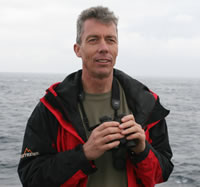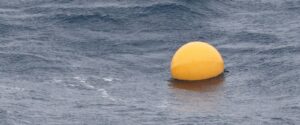 By Peter Ryan, onboard scientist, expert in general ornithology, seabird-fishery interactions, evolutionary ecology, marine debris, solid waste management, biology of oceanic islands.
By Peter Ryan, onboard scientist, expert in general ornithology, seabird-fishery interactions, evolutionary ecology, marine debris, solid waste management, biology of oceanic islands.
Leg 1, Day 13
After leaving Ile de la Possession yesterday evening, we headed for Kerguelen with a following sea and a cold 20-25 knot wind. Bird diversity was relatively poor, with prions, White-chinned Petrels and Wandering Albatrosses being the most conspicuous species throughout the day. Salvin’s and Antarctic Prions were equally abundant until mid-afternoon, when the latter started to dominate, and a few Slender-billed Prions were photographed. This gradual change makes sense given that Salvin’s Prions are restricted to the Prince Edwards and Crozets, Antarctic Prions occur in small numbers at the Crozets but are abundant at Kerguelen, and Slender-billed Prions are only found at Kerguelen in the Indian Ocean sector. A couple of Southern Royal Albatrosses circled the ship repeatedly among the more numerous Wandering Albatrosses, for once being reasonably friendly. A Fin Whale was seen briefly before breakfast; the only other cetacean sighting was a blow spotted by Dominic before lunch.
| Antarctic Prion | 50 | Salvin’s Prion | 40 |
| Black-bellied Storm Petrel | 34 | Soft-plumaged Petrel | 22 |
| White-chinned Petrel | 20 | White-headed Petrel | 9 |
| Wilson’s Storm Petrel | 6 | Wandering Albatross | 4 |
| Black-browed Albatross | 4 | Grey-headed Albatross | 4 |
| Northern Giant Petrel | 4 | Light-mantled Albatross | 3 |
| Kerguelen Petrel | 3 | Brown Skua | 2 |
| Southern Royal Albatross | 2 | Slender-billed Prion | 2 |
| Sooty Albatross | 1 | Indian Yellow-nosed Alby | + |
Kelps were observed regularly; all 19 were Bull Kelps Durvillaea antarctica, most of which carried growths of goose barnacles Lepas spp. After lunch we sighted a plastic fishing float, the first marine litter seen since before reaching Marion Island on 24 December.
